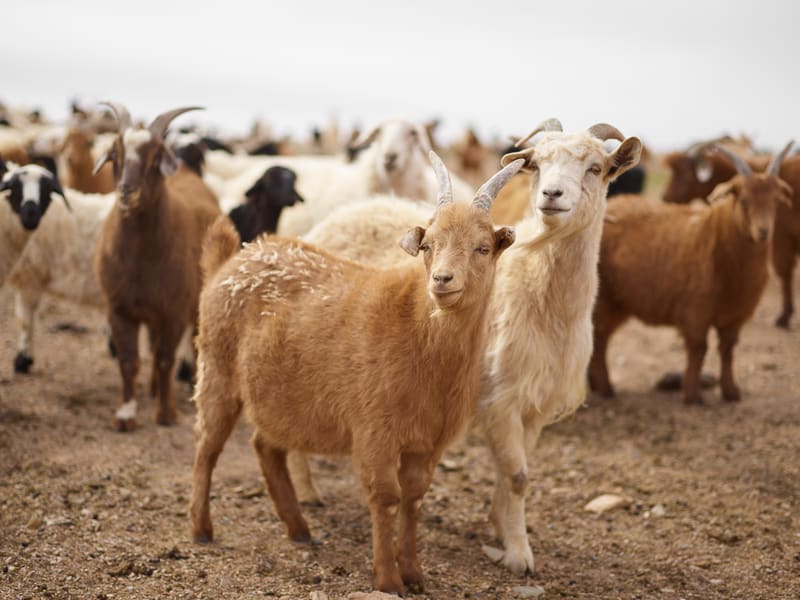[ad_1]
Is cashmere cruel? Cashmere wool is made by breeding, maintaining and harvesting the undercoat of goats treated as livestock and income-producing assets. On this alone, supporting the cashmere industry is considered cruel and unethical regarding goat welfare.
Goats are also highly destructive to the planet, causing more harm than good to ecosystems and wildlife. Should we then be breeding more?
Then you have Mongolian herders who have been shepherding cashmere goats for centuries. It’s a tradition passed down from generation to generation and is one of the few viable and respected careers in the region. What about them?
There’s a lot to unpack here as we explore the ethical nuances of the cashmere industry.
But first, let’s briefly break down this “magical” fabric and its premium price tag.
What is cashmere, and where does it come from?
Cashmere is a luxury fibre that’s soft, versatile and incredibly warm.
It’s 3 times more insulating than wool and thinner than a human strand of hair. This means you can wear a lightweight garment while still keeping warm.
Cashmere is most commonly used to make sweaters, scarfs and beanies. A typical cashmere sweater will cost anywhere between $120 to $1,000.


Why so expensive?
Well, cashmere fibre comes from the undercoats of specific goat breeds. These goats are commonly found across the Himalayas, where temperature can get down to minus 30 degrees Celsius (negative 22 degrees Fahrenheit).
The goats grow a very thick coat, and their inner hair (the cashmere) has very fine fibres to cope with the cold conditions.
Cashmere is harvested once a year, usually in spring when the goats are naturally starting to shed. Herders either clip or comb out the fibres when the goats moult.
The average cashmere yield for a goat is 200 grams (7.05 ounces). For comparison, sheep produce 3 kilograms (6.61 pounds) of wool a year.
Read more: Is Wool Vegan? Ethical Considerations of The Wool Industry
You’ll need 5-10 goats to produce just 1 cashmere sweater.
It’s the combination of infrequent harvesting, the relatively small yields, and the appealing properties that makes cashmere so premium.
How large is the cashmere industry?
Cashmere accounts for almost 7 per cent of the $71.2 billion global luxury market.
To get a slice of this lucrative pie, farmers have increased their flocks, and 29 million goats worldwide graze the steppes today, which is 5 times the number 30 years ago.
According to the International Wool Textile Organisation, approximately 25,208 tonnes of cashmere was produced in 2020.
China dominates raw cashmere exports, producing 60 per cent of global output, with Mongolia coming in second, making up 20 per cent of production.
The biggest importers of cashmere are in Europe (the United Kingdom, Italy and Germany), making up 38% of the global share in 2018.
While cashmere continues to be a strong market, with mindful consumers demanding more sustainable and ethical practices, big companies have boycotted cashmere to respond to these changing consumer preferences.
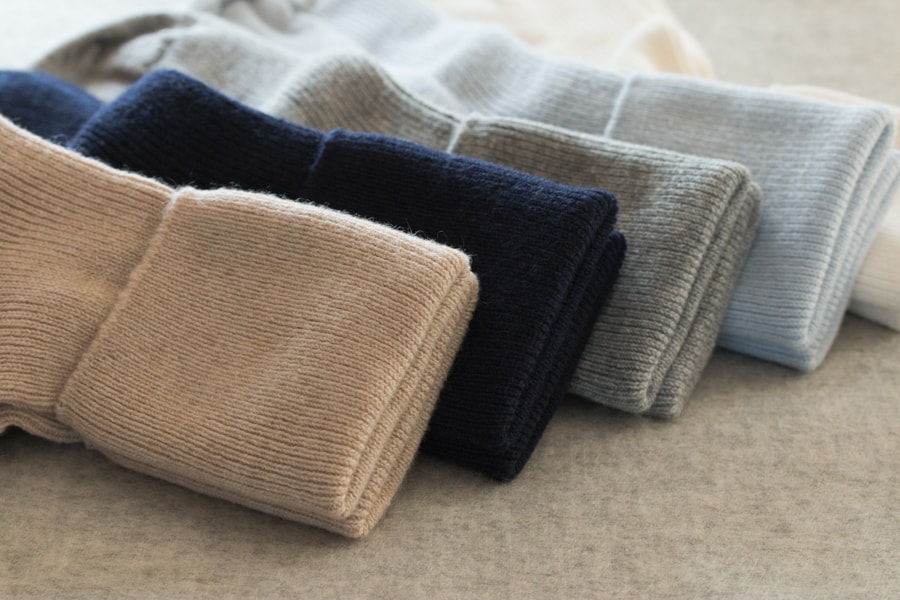

In 2019, large retailer ASOS pledged to ban any clothing made with cashmere (and mohair and silk) from their online store.
Patagonia made changes to restrict their clothing line only to use recycled cashmere.
Why the shifts? Growing concerns for animal welfare. Let’s dive a little deeper.
Read more: Is Mohair Ethical? What You Need To Know
Is cashmere cruel to animals?
To understand the levels of animal cruelty in the cashmere industry, we need to put the supply chain under the microscope. And what better place to start than with the 2 largest exporters: China and Mongolia.
The area responsible for most of China’s cashmere production is called Inner Mongolia. Inner Mongolia used to be part of Mongolia until China gained control of the region and renamed it. Outer Mongolia, the rest of the country, is what we know today as Mongolia.
Confusing, I know! But we need this context as we move forward.
Devastating cruelty at cashmere farming
At the more extreme end of the spectrum, footage has been captured of inhumane practices in China (Inner Mongolia), including:
- Goat’s throats are slit in slaughterhouses where other goats could be seen.
- Workers were seen stepping in and twisting goats limbs as they aggressively tore their hair out using metal combs.
- Goats are left with primarily untreated cuts and wounds without any veterinary care. Some workers were seen pouring rice wine on wounds.
- Workers were seen taking a hammer to a goat’s head, making for a slow and agonising death.
- Goats typically live to around 12 but are often seen unprofitable from 6 and slaughtered and sent off for meat prematurely.
There’s no doubt that these goats are exploited for their hair, and this practice is anything but ethical. However, just across the border is another approach to cashmere farming.
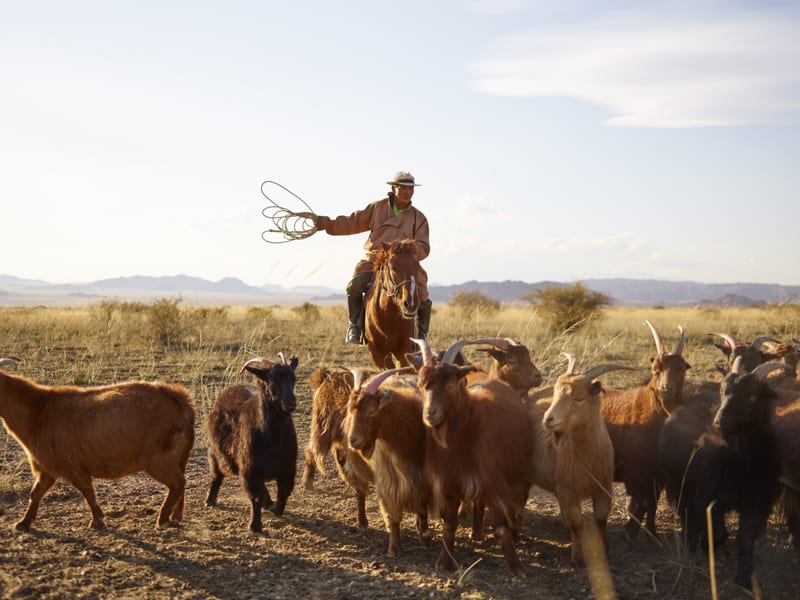

Less cruel practices in traditional Mongolian practices
As the climate changes in Mongolia, so do their herders. These semi-nomadic people use this to their advantage by moving between seasons to access new pastures that are better suited towards cashmere goats, who require more variety when it comes time to breed them — a strategy that has been perfected over centuries.
In contrast, the farmers in Inner Mongolia (China) who tend these animals can no longer move them between customary pastures due to increased industrialisation. They must now keep their herds inside barns most of the time with fences around them so that they do not wander off too far from human contact under Chinese law enforcement agencies’ watchful eye.
There’s a symbiotic relationship between Mongolian herders and their goats.
Unlike many other livestock production systems worldwide, it could be argued that Mongolian goats enjoy some of the greatest freedoms. There are no fences, and they roam freely without constraint or worry about getting lost in this vast landscape.
But even in this semi-wild lifestyle, the goats still face their share of hardships.
For instance, herders in the Gobi desert of Mongolia face high uncertainty and risk every day, but they have to be flexible for their herds’ needs.
The terrain is harsh with little water available; it can get up close to 35°C (95°F) during summer months or dip below -40°C (-40°F) in the wintertime.
However, unpredictable weather patterns make planning difficult because there may suddenly come flooding from heavy rainfall one week only then show no sign at all before another severe flood happens several days later.
Lack of food and water
Due to the rough weather, goats in the Gobi struggle to consume enough water. Without access to springs or rainwater, they’re dependent on ground wells and manual pumps for their hydration needs. Luckily these goats can go longer without drinking than most other animals.
Goats often starve during winter and spring when vegetation is at its most sparse. There are times of the year when goats will go days without eating because they cannot find anything to eat.
Some herds do receive supplementary feed, but it’s not enough for all members. Priority is given towards young or weak individuals first, ensuring survival rates stay high enough until warmer weather arrives again.
Lack of veterinary treatment
Private veterinary care is costly and difficult to access for many Mongolian goat herders. Of course, there are exceptions, but as a whole, this poses quite the problem.
If a goat gets sick or injured, it might be a while before they can treat their condition as veterinarians generally live in towns rather than making regular visits around the countryside.
Some won’t receive any treatment due to these constraints, and those that do may not get quality care.
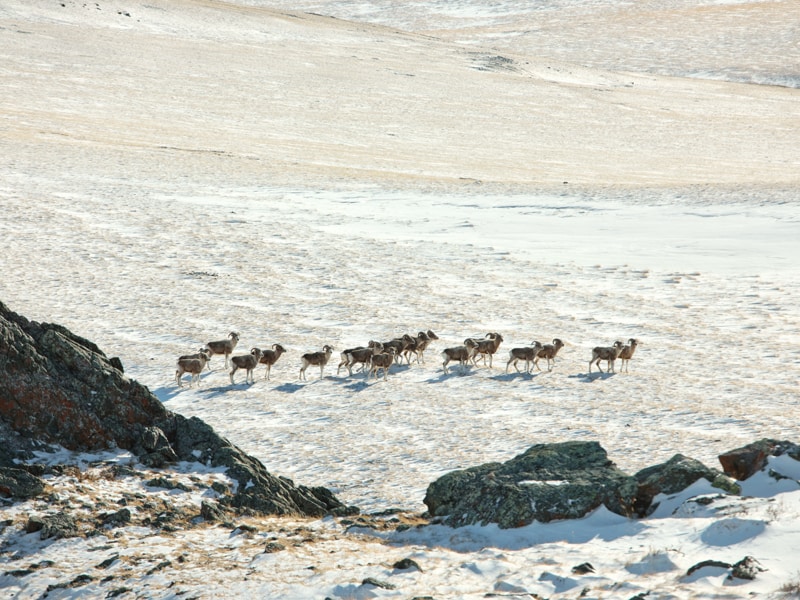

Painful castration process
Herders carry out castration surgeries without any anaesthetic, and it’s usually done at around 6 months of age, so billy’s cannot mate with females in the herd.
If it wasn’t for this process, there would be no way for herders to control how many offspring came from each animal (and thus, strong genetic traits could potentially disappear).
After removing the testicles, they’re typically boiled and used as part of a soup.
Goats are slaughtered for meat
Mongolian goats are slaughtered for meat once they get older, and the amount of cashmere produced by them reduces (along with its quality).
Goats are turned onto their backs, held by the legs, then they quickly plunge a sharp knife into the chest cavity to cut the main artery, ensuring swift death without spilling blood. Every part of these animals is used, including skin/fat or milk, to provide a food source for the herding communities.
So while the goats of Mongolia live a semi-nomadic lifestyle that rivals that of a wild upbringing, they’re still considered livestock. This isn’t a sanctuary. There’s monetary value associated with each goat.
Furthermore, goats are bred to exist in harsh weather conditions with a lack of food, water and veterinary care. And ultimately, once they’re no longer productive either for hair or milk, they’re slaughtered for meat.
It’s for these reasons that buying cashmere, whether it’s produced in conventional Chinese or traditional Mongolian practices, is still cruel to every farmed goat.
The environmental impact of cashmere farming
Cashmere herding dominates farming trades in Mongolia, with cashmere goats accounting for 41.3% of the total number of livestock, while sheep make up 45.5%.
BBS reports that there are 1.2 million nomadic herders in Mongolia, representing 40% of the country’s population.
As cashmere prices fluctuate and inflation goes up, producers feel immense pressure to increase herd numbers to keep their businesses afloat.
The cashmere goats of Mongolia are being ruined by a vicious cycle weakening the country’s supply chain and natural environment. As grass perishes, feed availability decreases for these animals, leading to undernourishment.
Fibre quality falls due to a lack of high-quality food sources like tree bark. This affects both yield levels and the price paid when selling cashmere fabric on international markets.
The result? Herders buy or breed more goats than ever before, offsetting any losses caused by lower yields.
Although Mongolia’s natural grasslands can barely sustain the increasing numbers, they damage topsoil and root structures with their sharp hooves. Goats nibble incredibly close to plant roots, which damage topsoil and root structure.
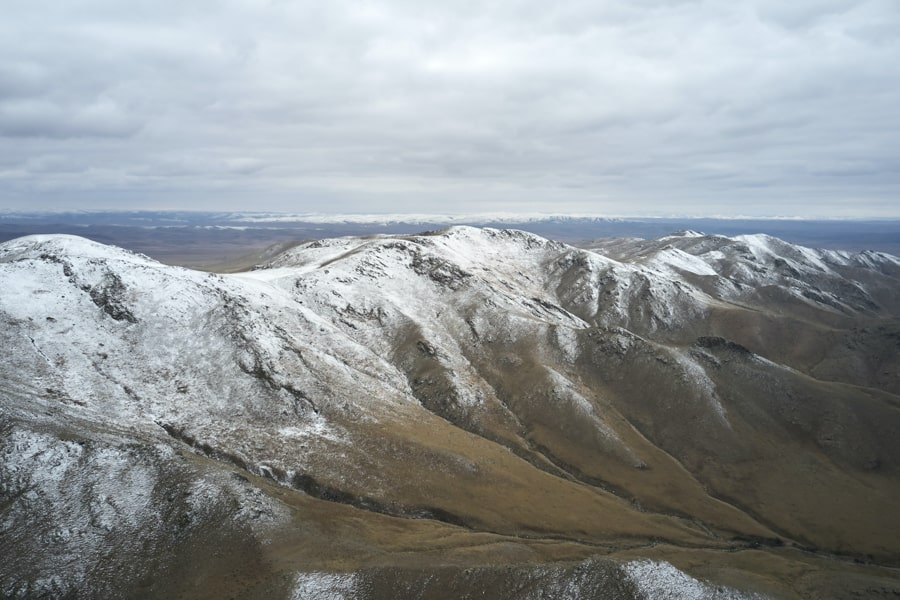

Currently, overgrazing has severely damaged 70 per cent of the grasslands, making them appear like deserts.
Overgrazing has harmed the habitats of numerous native big animals, which have struggled to survive.
Additionally, climate change is a factor since the intensified breeding of goats and other farmed animals contributes to increased methane emissions. According to goat herders in the region, the industry’s expansion is causing their grasslands to vanish.
The United Nations reported that almost 90 per cent of Mongolia is arid terrain, making it highly susceptible to desertification.
Mongolia is a hotbed for climate change, with temperatures increasing by 4°F since 1940 instead of the global average of 1.5 degrees.
In 2009 local meteorological stations reported a 150 per cent increase in disasters spurred by extreme weather events.
Herders are put in a difficult situation of balancing between making ends meet and keeping their herd numbers down to reduce environmental destruction.
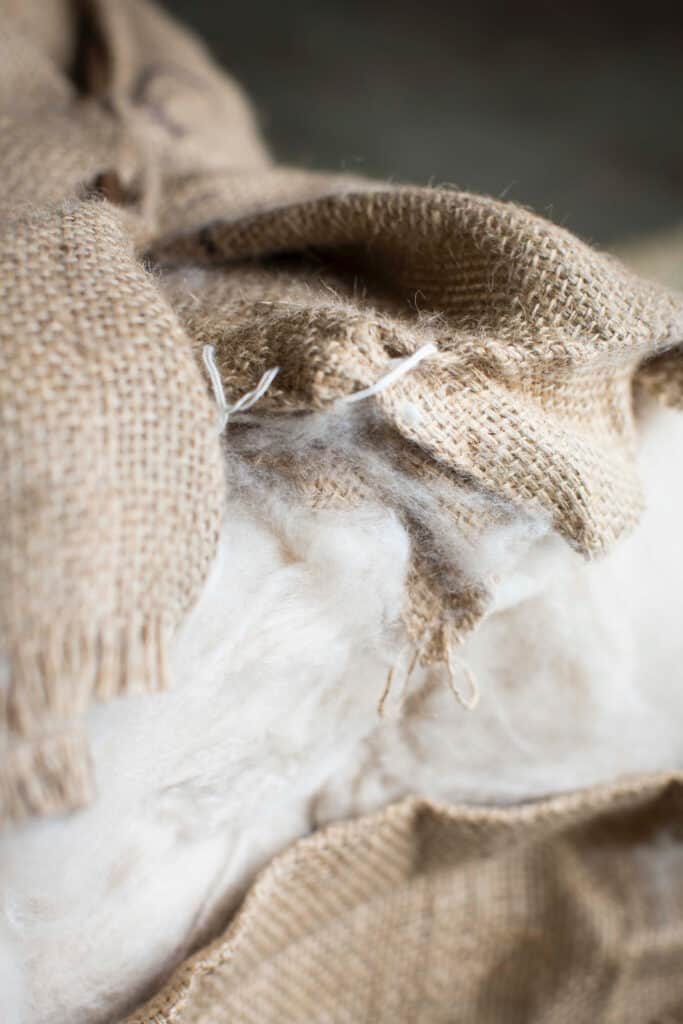

Is there such a thing as cruelty-free or vegan-friendly cashmere?
There isn’t a way of producing or farming cashmere that doesn’t affect the animals, humans, and environment in some way. For this reason, many fashion companies have boycotted cashmere from China and certain parts of Mongolia to promote ethical practices.
The environmental impact of cashmere farming continues to worsen as herders continue to breed more goats than their natural habitats can support. Unfortunately, there isn’t an easy solution to the problem that doesn’t put anyone further into poverty.
But there are some great alternatives to cashmere, including Re.VerSo made from pre-consumer factory left-overs of wool and cashmere by five of Italy’s leading textile producers. This is a completely transparent, certified and traceable system that has attracted the interest of designers who are keen to lower their environmental impact without sacrificing luxury.
Another promising sign is The Good Cashmere Standard, a non-profit organization dedicated to raising the standards of cashmere goats with respect to the Five Freedoms, as well as the economic, social, and environmental conditions faced by Inner Mongolia’s cashmere farmers, their families, and communities.
They’ve set clear criteria for sustainable cashmere production. Independent auditors regularly check to make sure these standards are being met.
If you do decide to purchase products using cashmere, look for items labelled with the Good Cashmere Standard. You can also find a list of partnered brands on their website.
It may be challenging to find truly sustainable and cruelty-free cashmere, but there are some great alternatives with a smaller environmental footprint.
Do you think supporting cashmere is cruel?
So, is buying cashmere cruel? The answer isn’t a simple yes or no. Traditional Mongolian practices in cashmere farming are less harsh on goats than conventional farming, but they come with their own ethical and environmental impacts.
There are cruelty-free options for cashmere, but they can be more expensive and harder to find. Ultimately, whether or not to buy cashmere comes down to personal choice. What do you think? Share your thoughts in the comments below.
[ad_2]
Source link
